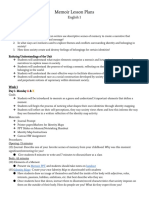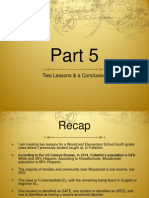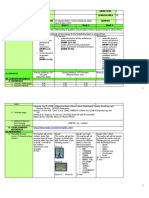Grade: 10 Subject: ELA Unit: Merchant of Venice - Consequences of Greed and Selflessness - 3 Lesson Duration: 73 Min. Date: Friday
Grade: 10 Subject: ELA Unit: Merchant of Venice - Consequences of Greed and Selflessness - 3 Lesson Duration: 73 Min. Date: Friday
Uploaded by
api-484940441Copyright:
Available Formats
Grade: 10 Subject: ELA Unit: Merchant of Venice - Consequences of Greed and Selflessness - 3 Lesson Duration: 73 Min. Date: Friday
Grade: 10 Subject: ELA Unit: Merchant of Venice - Consequences of Greed and Selflessness - 3 Lesson Duration: 73 Min. Date: Friday
Uploaded by
api-484940441Original Title
Copyright
Available Formats
Share this document
Did you find this document useful?
Is this content inappropriate?
Copyright:
Available Formats
Grade: 10 Subject: ELA Unit: Merchant of Venice - Consequences of Greed and Selflessness - 3 Lesson Duration: 73 Min. Date: Friday
Grade: 10 Subject: ELA Unit: Merchant of Venice - Consequences of Greed and Selflessness - 3 Lesson Duration: 73 Min. Date: Friday
Uploaded by
api-484940441Copyright:
Available Formats
Grade: 10
Subject: ELA
Unit: Merchant of Venice –Consequences of Greed and Selflessness -3
Lesson Duration: 73 min.
Date: Friday
OUTCOMES FROM 2013 MINISTERIAL ORDER: Cross-curricular Competencies
Outcomes (a to j from M.O.):
b) think critically: conceptualize, apply, analyze, synthesize, and evaluate to construct
knowledge
c) identify and solve complex problems
h) demonstrate good communication skills and the ability to work cooperatively with others
OUTCOMES FROM ALBERTA PROGRAM OF STUDIES
General Learning Outcomes:
2. Students will listen, speak, read, write, view and represent to comprehend literature and texts in oral,
print, visual and multimedia forms, and respond personally, critically and creatively.
4. Students will listen, speak, read, write, view and represent to create oral, print, visual and multimedia
texts, and enhance the clarity and artistry of communication.
5. Students will listen, speak, read, write, view and represent to respect, support and collaborate with
others.
Specific Learning Outcomes:
2.1.2.c Summarize the plot of a narrative, describe its setting and atmosphere, describe development
of conflict, and identify theme.
2.1.2.d Describe the personality traits, motivations, attitudes, values and relationships of characters
developed/persons presented in literature and other texts; and identify how the use of archetypes
adds to an appreciation of the text.
2.3.2d Describe character and characterization in terms of consistency of behaviour, motivation and
plausibility.
4.1.3.d Develop supporting details, by using developmental aids appropriate to form and purpose.
5.1.1b Analyze and describe language and images used in literature and other texts to convey
respectful and considerate, or disrespectful and inconsiderate, perspectives and attitudes.
OUTCOMES stated in learner friendly language
Students will:
● Work together to identify stereotyping.
● Consider the impact stereotypes have on various individuals.
● Compile examples of stereotypes, greed, and selflessness in a chart.
● Refer back to a text to answer comprehension questions.
● Contribute respectfully to class discussion.
ASSESSMENTS
Pre-assessment (prior Formative: Summative (if applicable):
knowledge) (if applicable): Venice Booklet
Brainstorming and Class discussion
defining stereotypes Think, Pair, Share
prior to beginning
stereotype activity.
LEARNING RESOURCES CONSULTED
Resource #1: Gibson, R. (2016). Teaching Shakespeare: A handbook for teachers (2nd ed.).
Cambridge, U.K.: Cambridge University Press.
Resource #2: Stereotype activity https://www.harmony.gov.au/get-involved/schools/lesson-
plans/lesson-plan-stereotypes/
MATERIALS AND EQUIPMENT
● Unit booklets
● Google Slides
● Audiobook
● The Merchant of Venice play
● Printed out restaurant employee cards for stereotype activity
PROCEDURE
Student Differentiation:
One student requires a
scribe to record notes. We
will be taking brief notes
during the scaffolding
activity that may be
recorded by the scribe.
Introduction (time: 5 min )
Hook/Attention Grabber: Ask students to define a stereotype based on what they know.
Students will have approximately a minute to think of what the word “stereotype” means to
them before sharing with their table groups.
Transition to Body: Since all students have participated in the introduction activity, a few
students will be asked to share their answers. The lesson begins by providing the definition of
a stereotype for our purposes as “a widely held but fixed and oversimplified image o idea of a
particular type of person or thing”.
Body (time: 65 )
Establishing ground-rules for stereotype activity: (5 min)
Let students know that the next activity may make us realize things about ourseves that
we maybe sometimes don’t like to acknowledge.
This activity is designed to help us identify and acknowledge our biases (prejudice in
favor of or against one thing, person, or group compared with another, usually in a way
considered to be unfair)
Like always, we will refrain from imposing our judgments on others in the class, and
we will be respectful towards everyone’s contribution.
Stereotype Whodunit Activity: (30 min.)
Read out the scenario to the class. Ask for six volunteers. Each volunteer will come stand at
the front of the room. Explain to students that the rest of them are customers in a restaurant.
The six volunteers are our restaurant employees. Each of the employees introduce
themselves to the diners, using the information provided for them on their card. The other
‘diners’ ask the employees questions to try to determine which one is guilty. The ‘employees’
improvise their answers. After a brief questioning period, the diners form groups of 3 or 4 and
are asked to discuss the information that has been presented in order to determine who the
guilty employee is. Each group will present their decision and reasoning to the whole class.
Ask students to consider their own thinking and answer the following questions either as a
large group or in table groups, depending on how students respond:
did we stereotype some of these people? How?
What assumptions did we make about individuals?
What sorts of things cause us to stereotype people?
Are stereotypes accurate or do they cause us to believe things that aren’t based on
facts?
Listen to Act I Scene ii: (15 min.)
Have students pay special attention to how Portia is characterized through the following
scene, and how she uses stereotypes in her descriptions of her potential suitors.
Venice Booklet: (10 min.) In our Venice booklet there are three discussion questions. Work
through the discussion questions as a table group.
If/when students finish their discussion questions, they are to look back in this scene
and the previous scene and record any evidence that will be used in either their
Character Playlist Assignment, or their Instagram PSA assignment.
Closure (time: 3 )
Feedback From Students on Learning: Group discussion, Venice booklets.
Transition To Next Lesson(s): Ask students to ensure their names are on their Venice
booklets and turn them into the bin. These are not taken in for marks, but I would like to know
if there is anything I need to go over in the play.
Reflection on lesson:
You might also like
- Lessonplanswk 7Document7 pagesLessonplanswk 7api-292487185No ratings yet
- Strategy Lesson 1Document5 pagesStrategy Lesson 1api-484708169No ratings yet
- Red Dog Unit Plan - Kimberley DoddDocument5 pagesRed Dog Unit Plan - Kimberley Doddapi-239323495100% (1)
- Cultural Diversity: StereotypesDocument3 pagesCultural Diversity: Stereotypespeg91793No ratings yet
- Week 7 Instruction 3 LittlepigsplanandreflectionDocument10 pagesWeek 7 Instruction 3 Littlepigsplanandreflectionapi-293703249No ratings yet
- Lesson Plan Curio ShopDocument2 pagesLesson Plan Curio Shopapi-216487546No ratings yet
- Wrong Lunch 2Document3 pagesWrong Lunch 2api-335446378No ratings yet
- G5 - ATG OutputDocument9 pagesG5 - ATG Outputmarcleorapa1234No ratings yet
- Mini Unit Plan Lesson 2Document7 pagesMini Unit Plan Lesson 2api-4007489840% (1)
- Sste 346 Project DesignDocument4 pagesSste 346 Project Designapi-337707834No ratings yet
- UNLV/Department of Teaching & Learning Elementary Lesson Plan TemplateDocument4 pagesUNLV/Department of Teaching & Learning Elementary Lesson Plan Templateapi-342077749No ratings yet
- Edu 280 Multicultural Lesson Plan 1 2Document4 pagesEdu 280 Multicultural Lesson Plan 1 2api-533889645No ratings yet
- Concept Unit Day 7 - EditDocument6 pagesConcept Unit Day 7 - Editapi-266951442No ratings yet
- Auto Generated LPDocument1 pageAuto Generated LPangelynpagaduan9No ratings yet
- Cbup LP2Document4 pagesCbup LP2Jane PatrickNo ratings yet
- Literacy Unit Plan CorrectionsDocument12 pagesLiteracy Unit Plan Correctionsapi-311313472No ratings yet
- Assessment Tool Overview: Assessme NT Tool Brief DescriptionDocument5 pagesAssessment Tool Overview: Assessme NT Tool Brief Descriptionapi-359979131No ratings yet
- Lesson Observation 1 EditDocument5 pagesLesson Observation 1 Editapi-385481283No ratings yet
- Lae 3333 2 Week Lesson PlanDocument37 pagesLae 3333 2 Week Lesson Planapi-242598382No ratings yet
- Slicepart 5Document24 pagesSlicepart 5api-260600835No ratings yet
- Integrated Lesson Planning Form - Respecting DifferencesDocument6 pagesIntegrated Lesson Planning Form - Respecting Differencesapi-257858054No ratings yet
- Interactive Read Aloud Lesson 2Document8 pagesInteractive Read Aloud Lesson 2api-399873247No ratings yet
- Annotatedlesson HarpernathalieDocument7 pagesAnnotatedlesson Harpernathalieapi-446222620No ratings yet
- Possible QuestionsDocument9 pagesPossible QuestionsjeekbergNo ratings yet
- Unit Plan: Baggage Stored, Perspective ExploredDocument30 pagesUnit Plan: Baggage Stored, Perspective Exploredapi-509984039No ratings yet
- Genre Project Unit PlanDocument45 pagesGenre Project Unit Planapi-242273696No ratings yet
- Edtp 635 Lesson PlanDocument10 pagesEdtp 635 Lesson Planapi-336418953No ratings yet
- Cep Lesson PlanDocument6 pagesCep Lesson Planapi-318256564No ratings yet
- Les Loisirs Unit PlanDocument10 pagesLes Loisirs Unit Planapi-324919699100% (2)
- STAGE 1: Desired Results: VIU Lesson Plan Jerome QUIVYDocument16 pagesSTAGE 1: Desired Results: VIU Lesson Plan Jerome QUIVYapi-478281868No ratings yet
- CensorshipDocument32 pagesCensorshipElmer CrisostomoNo ratings yet
- S3lessonplan-Recentversion 2Document11 pagesS3lessonplan-Recentversion 2api-229588643No ratings yet
- 1st Lesson Plan... The Community Garden..Document6 pages1st Lesson Plan... The Community Garden..OvalCatNo ratings yet
- Intelligence and Creativity Lesson PlanDocument3 pagesIntelligence and Creativity Lesson Planapi-548741425No ratings yet
- Lesson 7 Outsiders CH 5Document14 pagesLesson 7 Outsiders CH 5api-349579702No ratings yet
- Ed615 Lesson He Lion Bruh Bear and Bruh RabbitDocument10 pagesEd615 Lesson He Lion Bruh Bear and Bruh Rabbitapi-394394249No ratings yet
- Noting Context CluesDocument7 pagesNoting Context CluesMa Richell JuphaNo ratings yet
- The Hunger Games Propaganda, Perception and MediaDocument13 pagesThe Hunger Games Propaganda, Perception and MediaCarla MyskoNo ratings yet
- Who We Are 5threvisedDocument4 pagesWho We Are 5threvisedapi-242637744100% (1)
- Our Culture LessonDocument5 pagesOur Culture Lessonapi-740567085No ratings yet
- IAAAS LiteracySocialScience GradeK Q1UnitDocument6 pagesIAAAS LiteracySocialScience GradeK Q1UnitChuckGLPNo ratings yet
- Lesson Observation 3Document6 pagesLesson Observation 3api-385481283No ratings yet
- Tkam MypDocument5 pagesTkam Mypapi-300759812100% (1)
- Pioneer LessonDocument8 pagesPioneer Lessonapi-340407741No ratings yet
- Presentations Vocabulary Quiz Book QuizDocument9 pagesPresentations Vocabulary Quiz Book QuizSibel DoğanNo ratings yet
- Understanding by Design Unit TemplateDocument5 pagesUnderstanding by Design Unit Templateapi-318155534No ratings yet
- Kinder 1st Quarter Curriculum All About Me FinalDocument6 pagesKinder 1st Quarter Curriculum All About Me Finalapi-227929120No ratings yet
- Behind The CurtainDocument5 pagesBehind The Curtainapi-223111366No ratings yet
- Sample Classroom Activities For Creative WritingDocument8 pagesSample Classroom Activities For Creative WritingGrae SalesNo ratings yet
- The Bet Lesson PlanDocument10 pagesThe Bet Lesson Planapi-265180782100% (1)
- Planner How We Express OurselvesDocument4 pagesPlanner How We Express Ourselvesapi-318196512100% (7)
- Intro Lesson Plan To Genre Analysis UnitDocument5 pagesIntro Lesson Plan To Genre Analysis UnitDanahNo ratings yet
- EDTE4100Document39 pagesEDTE4100Leah WanNo ratings yet
- Gender and Society Syllabus For Learning UnitDocument10 pagesGender and Society Syllabus For Learning UnitOlivia NechitaNo ratings yet
- Drama Unit 1 - Orientation 2Document12 pagesDrama Unit 1 - Orientation 2api-300773127No ratings yet
- Curriculum Lesson PlanDocument6 pagesCurriculum Lesson Planapi-297642677No ratings yet
- SocraticseminarDocument6 pagesSocraticseminarapi-271086058No ratings yet
- Gibson Educ540 Lesson PlanDocument4 pagesGibson Educ540 Lesson Planapi-651691697No ratings yet
- Writing LessonDocument4 pagesWriting Lessonapi-350000132No ratings yet
- Using Art Critically Sampler: Using Art Critically SamplerFrom EverandUsing Art Critically Sampler: Using Art Critically SamplerNo ratings yet
- Professional ResumeDocument3 pagesProfessional Resumeapi-484940441No ratings yet
- Character Playlist AssignmentDocument2 pagesCharacter Playlist Assignmentapi-484940441100% (1)
- Reference Letter: On Behalf of Breanna CampbellDocument1 pageReference Letter: On Behalf of Breanna Campbellapi-484940441No ratings yet
- Crispin Creative ProjectDocument3 pagesCrispin Creative Projectapi-484940441No ratings yet
- Unit Plan PortfolioDocument20 pagesUnit Plan Portfolioapi-484940441No ratings yet
- f19 SnapshotDocument3 pagesf19 Snapshotapi-484940441No ratings yet
- Nadine Rose DissertationDocument7 pagesNadine Rose DissertationWebsiteThatWillWriteAPaperForYouSavannah100% (1)
- Ruta Mel Inglés IIDocument3 pagesRuta Mel Inglés IIwiliam omar alaya diosesNo ratings yet
- (2nd Year) Hci101Document14 pages(2nd Year) Hci101Joseph LapsoNo ratings yet
- Sarabjeet Kaur: Career OverviewDocument3 pagesSarabjeet Kaur: Career OverviewHRD CORP CONSULTANCYNo ratings yet
- 22pam0062 Intermediate Academic English Part2Document14 pages22pam0062 Intermediate Academic English Part2Marissa AmandarieNo ratings yet
- 07 Chapter 7 - Technology Assessment Strategy MakingDocument36 pages07 Chapter 7 - Technology Assessment Strategy MakingHustling MillionaireNo ratings yet
- Ministry ReportDocument3 pagesMinistry ReportDOMINIC KWOFIENo ratings yet
- CS8691 QB 002 Edubuzz360 PDFDocument137 pagesCS8691 QB 002 Edubuzz360 PDFBalaji SampathNo ratings yet
- Business EnglishDocument3 pagesBusiness Englishdeleven1111No ratings yet
- Critical Factors in Reading Comprehension Instruction For Students Teaching PPT 1Document17 pagesCritical Factors in Reading Comprehension Instruction For Students Teaching PPT 1api-300874571100% (1)
- Incorporation of Performance InformationDocument17 pagesIncorporation of Performance InformationveronicalvictorinoNo ratings yet
- Worksheet Activity 1Document3 pagesWorksheet Activity 1Florencito RivasNo ratings yet
- Negative Reinforcement HomeworkDocument5 pagesNegative Reinforcement Homeworkert78cgp100% (1)
- Grade 8 PE DLL Week 1Document9 pagesGrade 8 PE DLL Week 1Pagsibigan PO100% (2)
- IPM GR 3 Jan 2024Document113 pagesIPM GR 3 Jan 2024rauna01davidNo ratings yet
- Personal Development 1 July 1 and 3 WEEK 2Document5 pagesPersonal Development 1 July 1 and 3 WEEK 2Jessa De JesusNo ratings yet
- Evbare XdoneDocument41 pagesEvbare XdoneCaleb FalcoteloNo ratings yet
- Mager & Stevens (2015) - The Effects of Storytelling On Resilience in Older AdultsDocument105 pagesMager & Stevens (2015) - The Effects of Storytelling On Resilience in Older AdultsTrang BeeNo ratings yet
- Table of ContentsDocument7 pagesTable of ContentsmontillakurtkubainNo ratings yet
- Kanji: Radicals and ComponentsDocument7 pagesKanji: Radicals and ComponentsMichioNo ratings yet
- Psu Unofficial TranscriptDocument5 pagesPsu Unofficial Transcriptapi-264831328No ratings yet
- MAX SCHELER'S PHILOSOPHY ReviewerDocument2 pagesMAX SCHELER'S PHILOSOPHY ReviewerJohn Vince Bigtas SabianoNo ratings yet
- Oumh1303 English For Oral CommunicationDocument27 pagesOumh1303 English For Oral CommunicationSimon RajNo ratings yet
- CMC Vellore Dissertation TopicsDocument4 pagesCMC Vellore Dissertation TopicsThesisPapersForSaleSingapore100% (1)
- BETCK105EDocument4 pagesBETCK105ETalha AmaanNo ratings yet
- Redmon Resume2Document2 pagesRedmon Resume2api-491637331No ratings yet
- 70 Days Challenge - Part 2Document4 pages70 Days Challenge - Part 2abdulmuhymin10104No ratings yet
- BE Computer Engineering Syllabus 2019 CourseDocument3 pagesBE Computer Engineering Syllabus 2019 CourseMishra JiNo ratings yet
- Oracle Recruiting Cloud: Enhanced Duplicate Check Candidate Merge 19DDocument22 pagesOracle Recruiting Cloud: Enhanced Duplicate Check Candidate Merge 19DAlfredo El PireNo ratings yet
- AWS Certified Data Engineer - AssociateDocument2 pagesAWS Certified Data Engineer - AssociateVictor SolisNo ratings yet































































































